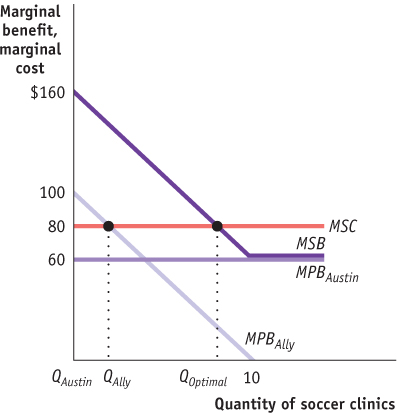Tackle the Test: Free-Response Questions
Question
Suppose Austin and Ally are the only soccer enthusiasts in a village where any number of public soccer clinics could be put on by visiting experts for $80 each. There are no external costs involved. Austin’s marginal private benefit curve for soccer clinics is horizontal at $60. Ally’s marginal private benefit curve is a straight line starting at $100 on the vertical axis and ending at 10 clinics on the horizontal axis. Draw a correctly labeled graph for soccer clinics showing the marginal social cost, the marginal social benefit, and each resident’s marginal private benefit. Label the quantity of clinics that Austin would purchase if he were the only resident as QAustin. Label the quantity of clinics that Ally would purchase if she were the only resident as QAlly. Label the optimal quantity of clinics for society as QOptimal.
Rubric for FRQ 1 (6 points):

1 point: Correct axis labels (“Marginal benefit, marginal cost” or “Dollars per unit” on the vertical axis, “Quantity of soccer clinics” or “Q” on the horizontal axis)
1 point: MSC curve horizontal at a height of $80
1 point: MSB curve starts at a height of $160 where the quantity is zero, slopes downward to a height of $60 where the quantity is 10, and then coincides with MPBAustin
1 point: QAustin labeled at a quantity of zero (because MSC exceeds MPBAustin for every clinic)
1 point: QAlly found at the intersection of MSC and MPBAlly and shown on the horizontal axis
1 point: QOptimal found at the intersection of MSC and MSB and shown on the horizontal axis
Question
Imagine that the city of Townville has 1,000 residents and pays $100,000 per year to rent a public good for the benefit of every member of the community.
Identify and explain the two characteristics shared by every public good.
Suppose a new resident moves to Townville. What is the additional cost of providing the public good to the new community member? Explain.(6 points)
Rubric for FRQ 2 (6 points)
1 point: Nonrival in consumption
1 point: The same unit of the good can be consumed by more than one person at the same time.
1 point: Nonexcludable
1 point: Suppliers of the good can’t prevent people who don’t pay from consuming the good.
1 point: The additional cost is zero.
1 point: Public goods are nonrival, so the same unit can be provided to additional community members at no added cost.